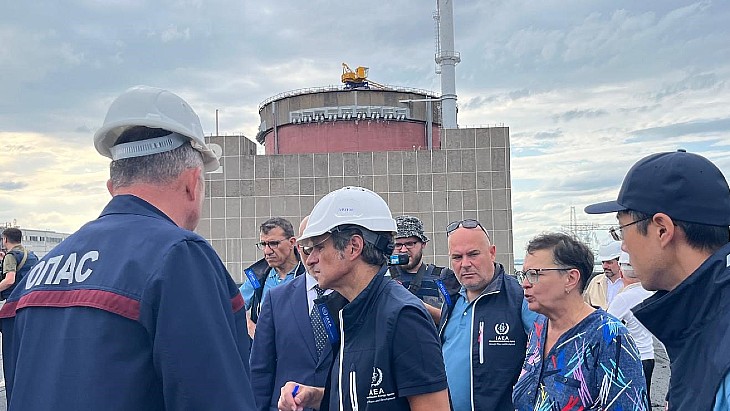Bulk of IAEA team leave Zaporizhzhia, two stay behind
05 September 2022
Four of the six International Atomic Energy Agency (IAEA) experts involved in the mission to the Russian-occupied nuclear power plant in Ukraine have now left the site after a five-day visit.
 The IAEA's director general led the mission, which began on 1 September (Image: IAEA)
The IAEA's director general led the mission, which began on 1 September (Image: IAEA)
Two members of the team are staying on at the six-unit Zaporizhzhia plant, Russian nuclear expert Renat Karchaa told TASS.
The full IAEA team was led on its mission to the nuclear power plant by its Director General, Rafael Mariano Grossi, on 1 September, after months of efforts to arrange a visit to the plant which has been under the control of the Russian military since early March, although it is still operated by its Ukrainian staff.
Grossi spent more than three hours at the site on Thursday. The State Nuclear Regulatory Inspectorate of Ukraine said that the six IAEA experts who remained at the site had completed their work on accounting and control of nuclear materials at the site and "conducted an inspection of the nuclear material in the declared places of its preservation". This fulfilled the regulatory pupose of the inspection to "verify the absence of undeclared nuclear materials at the site".
The mission, which has been assessing the damage, working conditions and other safety considerations at the site, had also been seen as a good way to bring more stability to the situation, but so far has not brought an end to fighting near the site. Ukrainian nuclear power plant operator Engeroatom said that it had been forced to shut down one of its two working reactors on Saturday evening after losing connection to its fourth and last remaining main external power line, although the facility is continuing to supply electricity to the grid through a reserve line, the IAEA added.
In its statement at the weekend, the IAEA said: "One reactor is still operating and producing electricity both for cooling and other essential safety functions at the site and for households, factories and others through the grid."
Grossi highlighted the benefit of having the IAEA experts on site: "Our team on the ground received direct, fast and reliable information about the latest significant development affecting the plant’s external power situation, as well as the operational status of the reactors. We already have a better understanding of the functionality of the reserve power line in connecting the facility to the grid. This is crucial information in assessing the overall situation there."
However on Monday afternoon Energoatom said that a fire caused by fresh shelling had disconnected "the last line linking the ZNPP/ ZTPP hub to the power system of Ukraine" adding that power unit 6, "currently powering the ZNPP's in-house needs, was unloaded and disconnected from the grid".
Speaking at the end of last week, Gossi told reporters after his visit that "it is obvious that the physical integrity" of the plant had been "violated several times - by chance, or deliberately, we don’t have the elements to assess that" but "this is the reality that we have to recognise and this is something that cannot continue to happen".
He said that during his visit on Thursday he "was able to tour the whole site, I went into the units, I could visit the emergency systems, the diesel generators, the control rooms … so we chose three or four key areas I needed to see first-hand. Of course I was able to talk to the staff as well".
He said that IAEA experts were carrying out detailed and continuous work to assess the physical damage to the plant’s facilities, determine the functionality of the main and back-up safety and security systems and evaluate the staff’s working conditions, in addition to performing urgent safeguards activities on the site.
The two sides in the war have blamed each other for the shelling of the area around the nuclear power plant. Grossi is expected to issue a report "about the safety, security and safeguards situation in Ukraine including the findings from his mission to the ZNPP" in the next day or two.
Researched and written by World Nuclear News